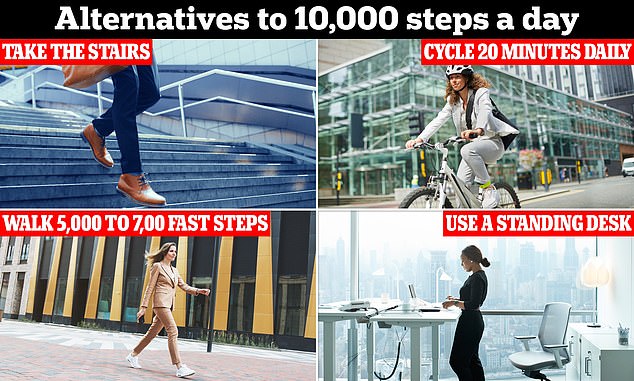Not enough time to walk 10,000 steps? Here’s what else you can do to fight off disease
Ten thousand steps are touted as the daily goal to get and stay healthy for years to come, but not everyone has the time to accomplish this daily feat – which takes about two hours a day.
If you find yourself walking laps around your kitchen to take those final steps, take advantage of these four less time-consuming alternatives recommended by doctors.
Walking 10,000 steps a day, equivalent to five miles a day, is seen as the best way to improve health, with studies suggesting it can help with everything from weight loss to reducing the risk of diseases such as heart disease and dementia.
But Americans average only about 5,000 to 7,000 steps per day, statistics show, with only 17 percent of people meeting the goal of 10,000 steps per day.
Below, DailyMail.com highlights four expert-recommended alternatives that may be more feasible on a daily basis.

Experts have revealed four hacks that can help you get the health benefits of 10,000 steps a day without walking the nearly five miles
Take the stairs
Walking five flights of stairs a day may have a similar health benefit as walking 10,000 steps a day, doctors say.
In a British study that followed 450,000 people for 12 years, researchers found that climbing stairs was linked to a nearly 20 percent lower risk of heart disease.


Dr. Lu Qi, an obesity expert at Tulane University in Louisiana, said: 'Short bursts of high-intensity stair climbing are a time-efficient way to improve cardiorespiratory fitness and lipid profile, especially among those unable to follow current recommendations. for physical activity.
'These findings highlight the potential benefits of stair climbing as a primary preventive measure for cardiovascular disease in the general population.'
The scientists considered one flight of stairs to be equivalent to 10 steps. They said people could climb all five flights at once or at different times during the day.
Climbing stairs causes an increase in heart rate, which improves blood circulation and cardiovascular health.
Some research also suggests that it may help strengthen the heart, lower blood pressure and reduce the risk of heart disease.
Climbing stairs also activates the muscles in the legs, which can improve the body's strength and overall endurance.


Exercise for less than half an hour
Cycling or jogging for less than half an hour a day has similar health benefits as the 'sweet spot' step, scientists say.
A meta-analysis of 11,000 people published in 2023 found that those who exercised for just 22 minutes a day had a 40 percent lower risk of death compared to those who did not exercise at all.
The participants, based in Europe and the US, did moderate to vigorous physical activities such as jogging, cycling and swimming.
By comparison, previous studies have shown that walking up to 10,000 steps per day reduces the risk of death by 42 percent for people in their 60s and older.
The scientists wrote in their conclusion: 'Higher (activity) time was associated with lower mortality risk, regardless of the amount of sedentary time.'
Exercise reduces the risk of many diseases, including heart disease, diabetes, obesity and even cancer.
It does this by improving the cardiovascular system and the function of the heart and lungs, thereby reducing the risk of disease.
Walk 5,000 to 7,000 quick steps per day
Walking fewer steps, but at a faster pace, can also provide the same exercise benefits, scientists say.
This is evident from a meta-analysis among 78,500 people, conducted by researchers in Denmark and Australia.
The study showed that walking 9,800 steps per day at a leisurely pace was optimal for reducing and halving the risk of dementia.


But taking just 6,300 steps at high speed made people 57 percent less likely to develop the condition. For power walkers, the risk was up to 62 percent lower.
Professor Emmanuel Stamatakis, senior author of the study and a public health expert at the University of Sydney, said: 'Step counting is easy to understand and widely used by the public to track activity levels thanks to the growing popularity of fitness trackers and apps , but that rarely happens. people think about the pace of their steps.'
Dr. Matthew Ahmadi, co-author and researcher at the university, added: 'The message here is that for protective health benefits, people could not only ideally aim for 10,000 steps a day, but could also try to walk faster.'
Walking at a brisk pace was defined as walking at least 40 steps per minute.
A separate study of 3,400 people found that 21 minutes of brisk walking – equivalent to almost 3,000 steps – also improved health compared to no activity. They defined speed walking as 100 steps per minute.
Joggers take about 150 steps per minute, while runners take about 170 to 180 steps per minute.
Dr. John Schuna, a kinesiologist at the University of Oregon who led the paper, said: 'Some physical activity is better than none, and usually more is better than less.
'When it comes to steps, more is better than less, and steps at a higher cadence for a significant amount of time are helpful.
'A good target for healthy adults is 150 minutes per week with 100 steps or more per minute.
'And when it comes to time spent sitting, less is better. You want to spend as little time as possible not moving, within reason.'


Buy a standing desk
Weight loss experts say purchasing a standing desk can help increase your step count.
Doctors at Midsouth Bariatrics, in Tennessee, say, “Investing in a standing desk is a great way to increase the number of steps you take while still staying productive.
'The elevated position provides a more natural movement pattern, which can easily lead to several hundred extra steps per day.
'Plus, your posture and energy levels can improve significantly.'
Doctors claim that people who use a standing desk are more likely to take extra steps because they are already standing.
This can help get them closer to the target number of 10,000 steps per day with ease.
